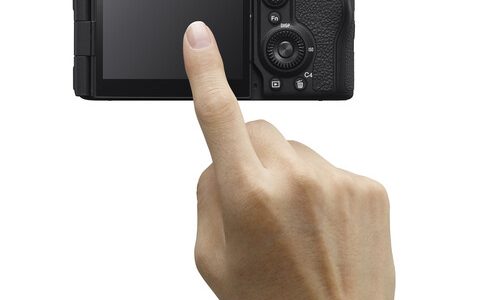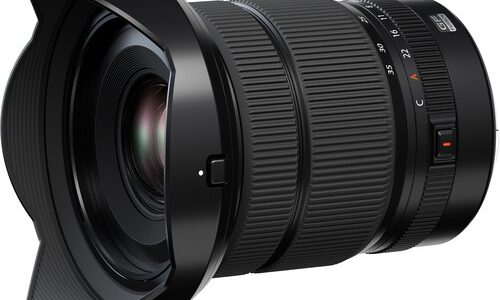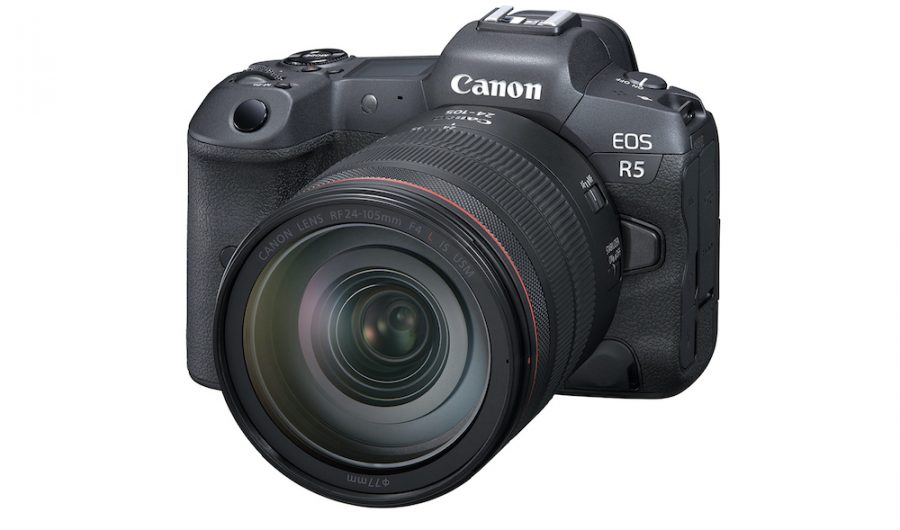


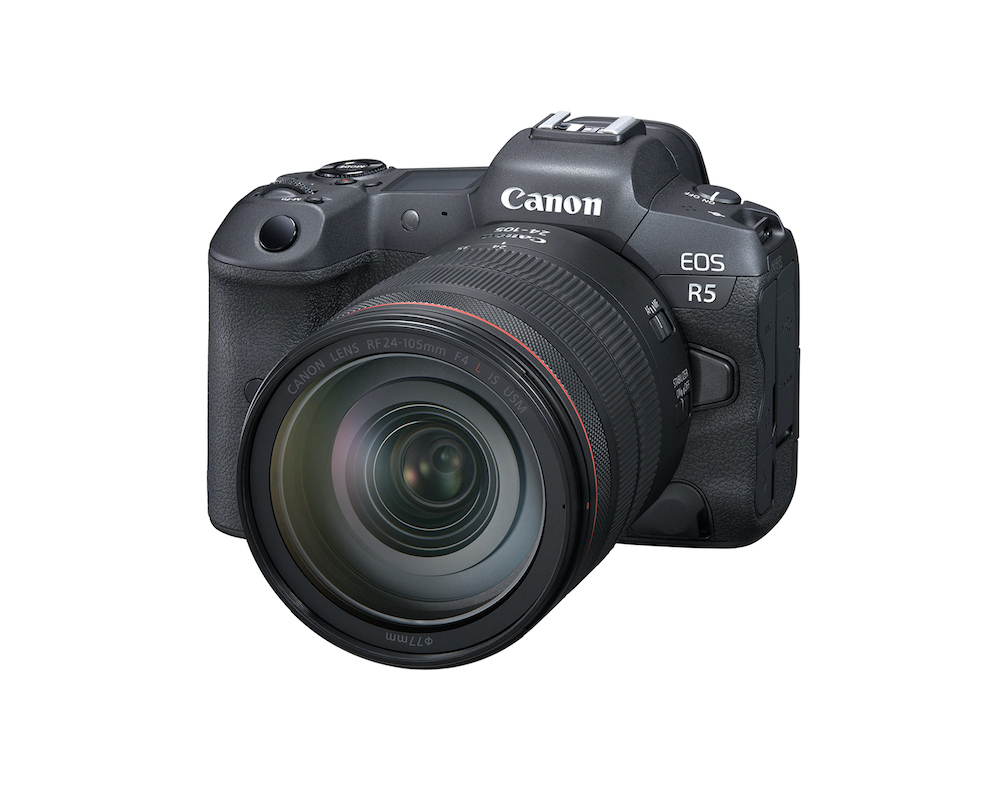
The 800-pound gorilla finally chose where to sit! Initial specifications of Canon’s new EOS R5 have been floating around online for a couple of months now, some from Canon development releases, others from leaks, and they have looked very interesting (to say the least). Early in the morning of July 9 (Eastern Standard Time), Canon actually released the EOS-R5, along with the lower-end EOS-R6 and several lenses. I have not yet seen the camera in person, although I have a request in for a review sample, and am very, VERY interested to try it. There are quite a few notable features, some new for Canon (in-body image stabilization), others new for the industry as a whole, especially on the video side (8K RAW video, 4Kp120 video). Does the EOS-R5 reshape the mirrorless landscape? For Canon shooters, certainly. If you are a Canon user, and have been waiting to see what the EOS-R system evolves into before moving to mirrorless, there is an awful lot to like about the EOS-R5, if the reality is anywhere near the spec sheet (and Canon has historically been good about not over-promising – Canons have a proud history of being well-debugged when they hit the shelves). Photographers with Canon EF glass should NOT overlook the first-party adapters that allow them to use their existing lenses at full performance on the new body – adding an EOS-R5 body and an RF lens or two to your Canon system is easy. I have been very complimentary of Nikon for how well this works, giving them credit for a large lens system as they get their native Z-mount lenses ready. Canon is in the same situation – actually a little better, because there are no early AF lenses that lose autofocus on the adapter. If you have Canon gear, this is probably the one you’ve been waiting for.
For high-end video shooters, the specs are also enticing. Basically nothing else shoots 8K30p 12-bit RAW video (!!!!!), at least not without paying close to $50,000 for a fully configured RED system (and only the higher-end RED bodies will do it). There is also an odd camera from a startup called ZCam that records 8K30p, but with highly restricted data rates much lower than what Canon is doing. Canon shoots their 8K RAW in-camera, without an external recorder, using the high speed of CFExpress to their advantage. There is an SD slot as well as the CFExpress slot, but the highest-end video modes (and the very deep buffer for still shooting) depend on CFExpress – make no mistake, this is a CFExpress camera that wants big, fast CFExpress cards.
The EOS-R5 also shoots 4K120p 10-bit (although not RAW), which is still very rare and restricted to some high-end cinema cameras. Not all of the cinema cameras with 4K120p are RED-level expensive – none of the Blackmagic Pocket Cinema cameras will do it, but the highest-end Ursa Mini Pro models will, and those start somewhat under $10,000 for a package (around $6000 for a body, but that is missing essentials like a viewfinder). At least the Blackmagic has a lens mount and a shutter button – RED has been known to charge extra for both. Some of Canon’s own Cinema EOS models also shoot 4K120p, again in the $10,000 range.
One thing to remember about 8K is that it is presently a future-proof acquisition format, not a display or distribution format. 8K TVs are still vanishingly rare and all over $2500. There is one 8K computer monitor in the consumer market, a nearly $4000 model from Dell that uses two cables to connect to the GPU. 8K projection almost literally does not exist (even the highest-end cinema projectors are 4K – there may be one or two 8K models for NASA-type installations), and there is either little or no 8K streaming content available for the few 8K TVs installed. About the only place where it would be possible to display an 8K video would be either in your home or office (if you own an 8K TV and a computer with a powerful enough GPU), or in a custom installation using a TV and probably a computer built for the purpose. Pretty restricted… This will, of course, change during the camera’s lifetime.
There is an excellent chance that Sony’s successor to the A7s II (which may or may not be called the A7s III), due later this month, joins the 4K120p parade, and a much smaller chance that it shoots 8K as well. Sony will most likely stick with their four-model strategy (with each model iterating mark numbers), where the A7s (or whatever new name they give it) focuses on video, possibly with a sub-20 MP sensor, probably with extreme high-ISO capability as well. The A7 is a general-purpose camera – very good video, very good 24 MP stills, cheapest price of the lot – the camera you need for the majority of photographers who have a desktop printer and aren’t pushing the edge of what video can do.
The A7r is the pixel monster for people who print big and want the best possible still files. The A9 is for sports photographers who want ultra-high still frame rates and the best possible AF. A small number of rumors have focused on Sony giving the “A7s mk III” a hybrid sensor that offers both very high readout rates for video and high resolution (possibly with an unusual quad-Bayer filter pattern that makes pixel binning easy) The preponderance of rumors, however, suggest a very fast, lower-resolution sensor somewhere between 12 and 24 MP (one possible sensor is 15.3 MP) with superb video.
Nikon is doing essentially what Sony does, except that their sports camera is a DSLR and they don’t make a video-centric model. The Z6 is Nikon’s answer to the A7 line, and the Z7 is their answer to the A7r line. Their A9 competitor is the D6 (and its many predecessors, going back to the original Nikon F of 1959). Nikon has never really been a video company, although the Z6 and Z7 both offer very good video that would have been beyond excellent only a few years ago. There is probably not a large group of existing Nikon cinematographers who are waiting for a video-first Nikon body, although Nikon shooters who do both stills and video have reason to be happy, and Nikon will certainly improve the video farther in their successors. Nikon is more likely to follow the Canon strategy (exceptional video in a selected body that is also a superb still camera) than the Sony/Panasonic strategy of putting their best video in a more or less dedicated video camera. Both Sony and Panasonic were video and cinema camera companies before they really entered the still camera market, while Canon’s and Nikon’s cultures and histories are in still photography.
Canon has done something very different here – they are relying on a DSLR (the EOS 1Dx mk III) as their sports camera, but the high frame rate and deep buffer (180 frames in RAW mode at 12 fps to a fast CFExpress card – 83 frames even at 20 fps with the electronic shutter) of the EOS-R5 make it a viable choice for sports as well. Is the AF up to the standards set by the EOS 1Dx mk III, the A9 and the D6? That will need a camera in hand, but if it is, the EOS-R5 can serve as a sports camera/video-centric body/pixel monster. That’s three Sony cameras or two Nikons plus a video camera they don’t make… The EOS-R6, also released today, is Canon’s less expensive answer to the A7 and Z6 lines, and it is essentially aiming for that large, jack-of-all-trades market.
In addition to the unprecedented video capabilities for anything that vaguely passes as a still camera, the EOS-R5’s still photography chops are well beyond anything we’ve yet seen from Canon, and competitive with anything from anyone else short of the GFX 100. There are two real headline features for the still photographer – Canon’s first attempt at in-body image stabilization in an interchangeable-lens camera and the resolution and (claimed) dynamic range of the sensor.
Not only has Canon finally released a camera with in-body image stabilization (IBIS), they have released one with nearly unprecedented IBIS specs. Most full-frame cameras with in-body image stabilization claim something like 5 stops of correction with most lenses (either the lenses generally aren’t stabilized OR the combination is around 5 stops). Cameras with smaller sensors do somewhat better, ranging up to some Olympus body/lens combinations that claim 7-7.5 stops. Canon is claiming 8 stops of stabilization with certain lenses, a record so far, and the list of lenses that feature 7 or 8 stops is impressive. I haven’t tried Canon’s new system, of course. My experience is that all CIPA image-stabilization claims are exaggerated in real-world conditions, but the ratio between them is about right in cameras I’ve shot.
I can shoot my Nikon Z7 (5.5 stops claimed) down to 1/30 second easily and sometimes 1/15 second with the 24-70mm f4 lens at its long end. Without any stabilization, I’d want to shoot that body and lens around 1/250 or 1/300 second (the higher the resolution, the faster the shutter speed you need for real pixel-level sharpness). That’s between 3 and 4+ stops of stabilization. In a similar situation, I can shoot a friend’s EM-1 mk II down to 1/8 second easily and sometimes ¼ second. Olympus claims 6.5-7 stops, and I’m getting an honest 5+ stops. If we assume Canon’s numbers are about as true as everybody else’s (since the CIPA test circumstances are standard, they should be), they’re looking at ¼ second or so with a midrange zoom. That is impressive under any circumstances, but especially for a high-resolution, full-frame camera.
Where did Canon come up with an IBIS system like that, without having worked the kinks out in several lesser iterations first? Is it possible they bought it from Olympus? There is no evidence pointing in this direction, except that Olympus is selling off camera assets and Canon comes up with something they’ve never had before in an area where Olympus is the market leader. Of course, any deal like that would have to have been worked out several years ago, when Olympus was still actively developing cameras. Canon is also one of the world’s largest patent holders, with research in a wide range of fields, so they could have independently developed a really top-notch IBIS system and waited to release it until they had a world-class system. Whether they made it themselves or bought it, it looks like Canon has a winner of an IBIS system. The few people who’ve actually had their hands on it say that the IBIS is impressive, both for stills and video. It seems to be very good at detecting deliberate panning motion and not fighting against it, an area where the Olympus system is also excellent.
The second headline feature Is the high-resolution sensor. Canon finally matches other high-resolution full-frame mirrorless bodies, after their first two entries were both in the decidedly mid-resolution range. Yes, Canon did have a 50 MP sensor in the EOS-5Ds and 5DsR DSLRs, but it had limited dynamic range and was generally considered to have lower overall image quality than the Sony/Nikon/Pentax 36 MP sensor, let alone its 40+ MP successors. Since production EOS-R5s are not yet out, there are no high-resolution sample images. Canon claims “about 1 stop more dynamic range than the original EOS-R”. Looking at the generally reliable dynamic range data posted on Photons to Photos for existing cameras including the EOS-R, the EOS-R is approximately a stop behind the market-leading Sonys and Nikons at low ISOs, coming closer at higher ISOs. If Canon’s claims are accurate, the EOS-R5 should be right in with the class leaders at low ISO, and possibly in the lead at higher ISOs. Canon’s colors have always been excellent, and the EOS-R5 should follow in that tradition.
Without actually working with the camera, or at least seeing high-resolution samples, it is impossible to say more about image quality than the resolution, Canon’s claims about the dynamic range and a little bit about color from some videos (with stills embedded) from preproduction models. All of the above look excellent, but none are definitive.
The EOS-R5 features the same 5.76 million dot viewfinder as the latest Sonys, the Leica SL2 and the Panasonic S1, S1H and S1R. It is presently the sharpest viewfinder on the market, although the upcoming Sony may use something even higher resolution. Viewfinder optics matter as much as what the screen itself is, and that will be hard or impossible to judge without seeing the camera – but early testers like the viewfinder.
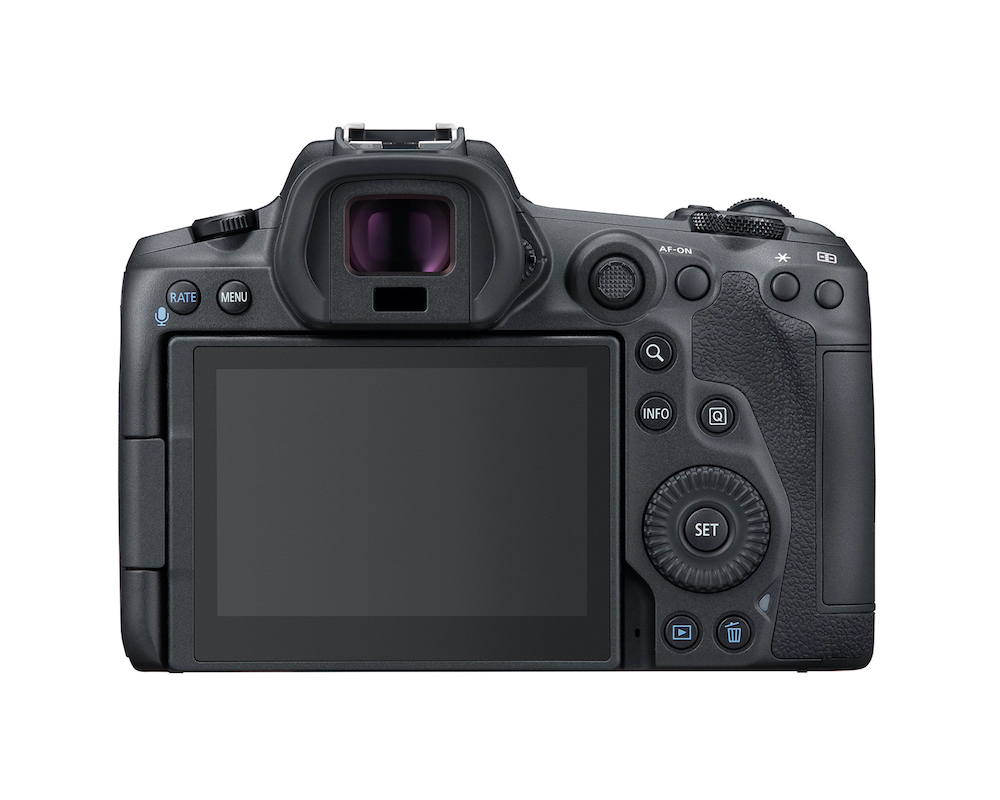
One of the most important and positive features of the EOS-R5 is that it speaks Canonish. The original EOS-R had quite a few handling quirks, and the EOS-M series have been all over the place, not always handling like Canons at all. The EOS-R5 looks like a smaller Canon 5D series camera, and people who have handled one say that it is very similar to the 5D mk IV. The rear controls are very similar to the 5D mk IV, while the top plate is taken more from the EOS-R, but the overall result says “Canon”. The menus are typically Canon as well, and the weather sealing is described as similar to the 5D mk IV. The 5D series has become better and better sealed over the years. One of the criticisms of the original EOS-5D is that it used a consumer body (actually less well built than contemporary Canon APS-C DSLRs) to let them fit the expensive full-frame sensor in a less expensive camera. The 5D mk II introduced weather sealing, the 5D mk III improved it, and the 5D mk IV is as well sealed as anything except the big sports cameras and possibly some Pentax and Olympus models that emphasize sealing.
There are a couple of caveats that have appeared in generally very positive early impressions. Two of them have to do with the exceptionally high video specifications… The higher-end video modes use an enormous amount of storage space and generate a ton of heat as well. In 8K RAW mode, the EOS-R5 is capable of generating nearly 3 gigabits per second of video data. There is no SD card capable of recording at that speed, requiring use of the extremely fast CFExpress slot. The recording time is only 40 minutes per terabyte of card space! Fortunately, terabyte CFExpress cards (and even a 2 terabyte model) exist, but they are very expensive (~$800 – $900 apiece). Oddly, B&H lists the not-yet released 2 TB card at $1000, massively cheaper per byte than any 1 TB option. Not only are card recording times short, storing the footage is a major challenge – expect to be dealing with big, fast RAIDs.
The record time before overheating is only about 20 minutes per take (depending on conditions), then the camera needs to be rested before filming again. Video modes like that are not really intended for filming extended interviews or other lengthy single takes (the purpose is cinematography, and most individual movie shots last well under a minute), and the lesser modes that are more appropriate for long takes do not overheat nearly as fast. It would be just about impossible to design a camera that pushed as much data through as this one can and didn’t heat up, unless it was much bigger and used active cooling (fans). There is a reason that REDs are big magnesium “brick” bodies, and that the Blackmagic that shoots 4K120p is a 7+ lb Ursa, rather than a pocket cinema camera. Even in modes where overheating is less limiting, the EOS-R5 has a 29 minute, 59 second limit per take (shared with most still-video hybrids, and intended to get around a tax law in the European Union). When recording cuts off due to European taxes instead of heat, it can, of course be restarted right away.
The one major limit apparent so far that doesn’t have to do with the high-end video modes is that battery life is, in a word, lousy. The worst-case scenario is using the viewfinder at its full 120 fps refresh rate. The CIPA rating (which is almost always pessimistic) under those circumstances is only 220 shots – about the worst we’ve seen on any camera (older Sonys that used the tiny NP-FW50 batteries and Fujifilms prior to the X-T4 (which uses a new battery) in boost mode are both similar). Turn the viewfinder refresh down to a still very respectable 60 fps and battery life goes up to 320 shots, still lower than preferred, but no longer horrible. With the viewfinder in the slower refresh mode, the CIPA rating is comparable to the Z7 with the viewfinder in its fastest mode (although nowhere near the rated life of newer Sonys that use the similarly sized NP-FZ100 battery), and the Z7 has relatively acceptable real-world battery life. Using the rear LCD in power-save mode, the CIPA rating goes up to as much as 490 shots. Unlike the very short-lived Sonys and Fujifilms, the EOS-R5 is using a decent-sized battery, a new version of the LP-E6 that powers the 5D series and the original EOS-R, among other Canon models. Most Canon shooters already have a drawer full of them, and newer models can be recharged in camera via USB, as well as in any LP-E6 charger.
The EOS-R5 is a relatively large and heavy mirrorless camera, slightly bigger and heavier than most of its full-frame competitors such as the A7 series or the Z series. It is similar in size and weight to an advanced APS-C DSLR like the Nikon D7500 or Canon’s own EOS 90D, and it is substantially smaller and lighter than most full-frame DSLRs or than Panasonic’s very large S1 series mirrorless cameras. Many of the RF lenses so far have tended to be on the larger and heavier side as well, although this is not universal.
Who is this for? If you are a Canon shooter looking to move to mirrorless, or to add high-end mirrorless to your system, the supremely capable EOS-R5 should get you off the fence. It’s fast, it’s high resolution, and it has absurd video modes. It’s on the more expensive side for a mirrorless body ($3899), right in the same price range with the Panasonic S1R and S1H, $300 more than the Sony A7r IV, and substantially more expensive than the $2800 Nikon Z7. Unfortunately, Canon isn’t offering any discount on the bundle with the 24-105mm f4 lens (neither does Sony, but Nikon offers very good deals with the excellent 24-70mm f4 and/or the FTZ adapter). If you have a Canon system and you want a camera like this, the investment is almost certainly worth it.
If you are a still/video hybrid shooter presently working in Micro 4/3, but tired of the Same Old Sensor, the EOS-R5 may be your best ticket to a new system. Panasonic would prefer it if you moved to L-Mount , of course – but RF seems like a far safer course than L-mount, especially because of the EF adapters. The EOS-R5 gives up nothing to Olympus in image stabilization, nor to Panasonic in video capability, and it is part of one of the most likely systems to remain supported in the longer term.
It is well worth watching the next Sony introduction as well, to see which body you like better, and looking at the systems in comparison to your own needs. Unless Sony surprises us with a much higher resolution still camera than most people expect of their next video flagship, a Sony hybrid system will probably need two different bodies (which share lenses and batteries) if the video capabilities of the A7r IV are not sufficient for your needs. Canon is providing ultra-high end video capability in the same body as their best stills. If you want a backup body, you can choose between another EOS-R5, a less expensive EOS-R6 or even an older model EOS-R or EOS-RP, but you don’t need a specific pairing to get all the capabilities. The new video-centric Sony may use some form of cooling technology to alleviate the overheating problem of moving all that data around.
If you are interested in moving away from Micro 4/3 (or Pentax) because you are afraid of your system’s viability and tired of stagnant image quality, but are not a high-end video shooter, the EOS-R5 is certainly worth a close look. If the image stabilization is as good as Canon says, it gives up little or nothing, even to Olympus, while offering a massive improvement in image quality. It will be substantially bulkier than you’re used to. If you don’t need the extremely high-end video modes, Nikon and Sony are also very worth a look, and Fujifilm APS-C also offers a huge improvement in image quality (and excellent stabilization on the X-T4) while staying closer to the size you are used to. Any of the Big Four could be right for you.
If you own another of the Big Four systems (Nikon, Sony, Fujifilm), there is almost certainly nothing here to switch you to Canon unless you are very unhappy with what you have (or you have the very rare contract to shoot 8K video). Why the EOS-R5, new lenses and a whole new system to learn instead of your own system’s similar body and your own lenses? An EOS-R5 will produce stunning big prints, but so will a Z7, an A7r IV or a GFX 50R. Unless you’re using the very highest-end video modes, a Z6 or Z7, an A7 III or A7r IV, and an X-T4 are highly competent, stabilized video cameras. Even at the very highest levels of video, Sony users probably have only weeks to wait for Sony’s answer.
The one exception is if your present system is APS-C and you have a real need for the higher image quality of high-resolution full frame (you like to print big). If you have an APS-C system other than Fujifilm, you are in a situation more closely related to the Micro 4/3 or Pentax shooter than the person who has an investment in a viable system. Nobody except Fujifilm seems to be putting a lot of effort into the development of APS-C bodies or lenses above the entry level. Due to some shared accessories and familiarity, look at your existing brand’s full-frame options first, especially if you have some full-frame lenses – but it’s worth considering the others as well. If your APS-C system IS Fujifilm, you are in a somewhat different (and better) situation, because your system is getting interesting new bodies and lenses.
What else did Canon introduce today? I have focused on the groundbreaking EOS-R5, rather than its EOS-R6 stablemate, because there is so much more to discuss about the R5. The R6 is very likely an excellent camera, but it follows a path well-trodden. It’s not enormously different from the existing EOS-R – better video, but lower-resolution stills, a more standard Canon control scheme. It uses a variant of the sensor from the EOS-1Dx III, limiting it to 20 MP, but providing superb high-ISO capability. It is Canon’s second (or third, although the EOS-RP is really something different at the very low end) generation of the standard mid-resolution full-frame mirrorless idea. Sony is now on their third generation of a similar camera, and we may soon see a fourth. Nikon and Panasonic have both introduced their own versions. They are all a great deal more alike than they are different, and the choice between them should be determined by what fits with what you already have, and by what fits best in your hand. One point always worth making about these cameras is that the X-T4 is in the same category, even though it’s APS-C. Its great lenses and similar resolution lead to very similar image quality…
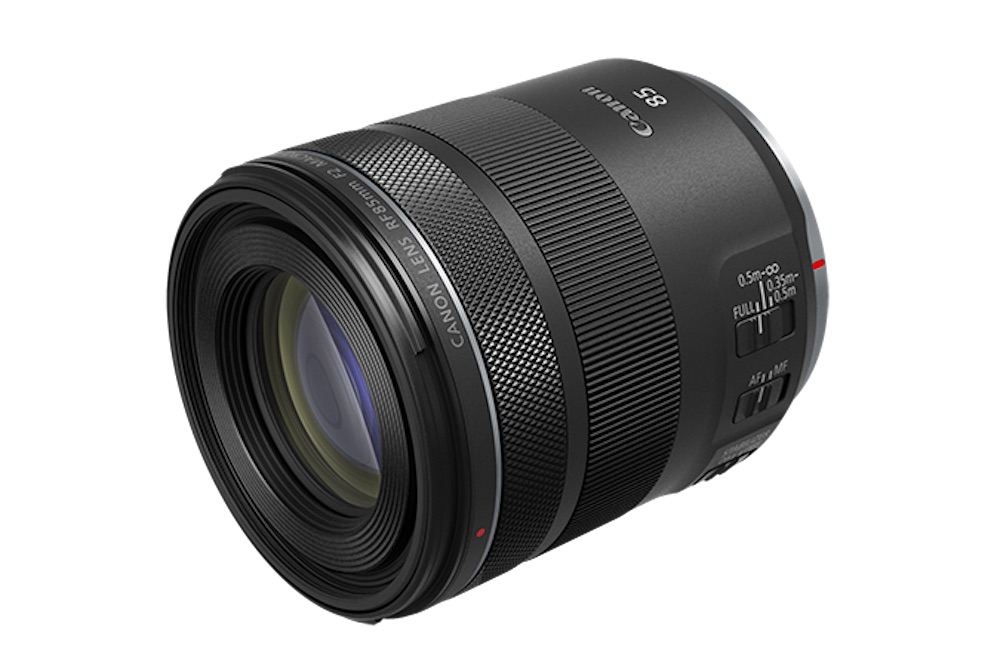
Canon also introduced four lenses, two of them definitely weird, and one more right on the edge of being weird. With no sample images, it is impossible to say anything about the image quality of the lenses! The most conventional of the four is a $600 85mm f2.0 macro lens. It’s a little shorter than the usual 100-105mm macro lenses, it’s a stop faster, and it’s not a 1:1 macro lens (it’s 1:2). Is it a great budget portrait lens with close-focusing capability? It’s actually closer to an 85mm f1.8 that happens to focus close than it is to the usual macro lens in the 105mm range. Both Sony and Nikon make similar mirrorless lenses without the close-focusing capability, all are in the same price, size and weight range (the extremely sharp Nikkor is $200 more), and the Sony and Nikon lenses get excellent reviews. How will Canon’s choice to give up 1/3 of a stop of maximum aperture in favor of close focus be received?
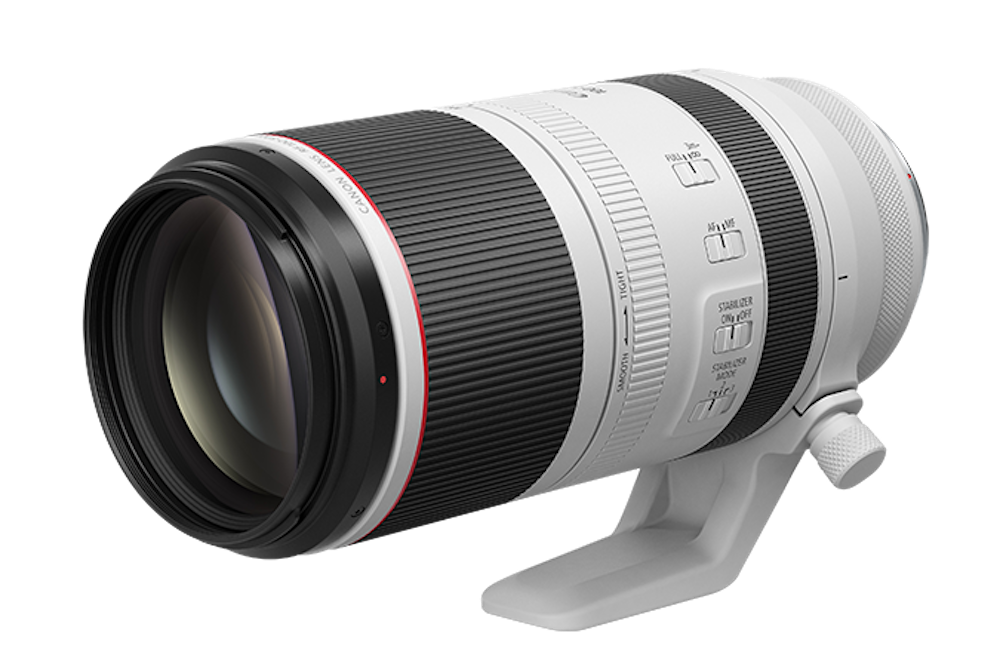
The arguably weird lens is the relatively expensive RF 100-500mm f4.5-7.1 L. At first, the specifications don’t seem to make sense… An f7.1 L lens? An f7.1 lens that costs $2700? The key to understanding this lens is that it’s really a 100-400mm f4.5-5.6 lens with a (slow) extra 100mm. It doesn’t jump from f5.6 to f6.3 until 363mm, and it doesn’t make the final jump to f7.1 until 472mm. It weighs 1370 grams and takes 77mm filters.
There are at least four other lenses in the 80-400 or 100-400mm category, made by camera manufacturers – Sony, Fujifilm, Nikon and Canon’s own DSLR lens. They range in price from $1899 (Fujifilm) to $2499 (Sony), and in weight from 1375 grams (Fujifilm) to 1640 grams (Canon). All take 77mm filters, and all have a maximum aperture of f5.6 at the long end. The Fujifilm and Sony are extremely well-reviewed, while the Nikkor looks a little long in the tooth compared to their newer telephotos, especially the two PF lenses and the 200-500mm f5.6, all of which compete with it. Canon made a design tradeoff here – they accepted a slightly slower aperture from 363 to 400mm in order to squeeze in the extra 100mm. If the lens performs well, it’s an interesting and probably worthwhile decision.
What the 100-500mm looks like at first glance, but is not, is something like the Nikkor 200-500mm f5.6 or the Sony 200-600mm f5.6-6.3. Those lenses make very different tradeoffs. They’re actually less expensive, perhaps because it is optically complex to get the lens down to 100mm on the wide end (and into the size and weight range of a typical 100-400mm). They’re more than 1.5x the size and weight of lenses in the 100-400mm class, and they take 95mm filters. Both the Sony and Nikon lenses are optically excellent, and are bargain ways of getting some serious reach at a reasonable aperture.
The only high-quality 500mm lens I am aware of in the same size and weight range as the Canon RF 100-500mm is the Nikkor 500mm f5.6 PF. An interesting tradeoff (if the mount choice didn’t matter)… The Nikkor is 2/3 of a stop faster (although it’s only nominally 1/3 of a stop faster at 471mm on the Canon), but it’s $1000 more expensive, takes 95mm filters, and it doesn’t zoom. The Nikkor is a truly excellent lens – how will the Canon do? If it’s a great lens, it’s a very interesting design that nobody has tried before. Yes, the last 100mm are quite slow, but they’re a bonus on a 100-400mm lens that happens to go to 500mm.
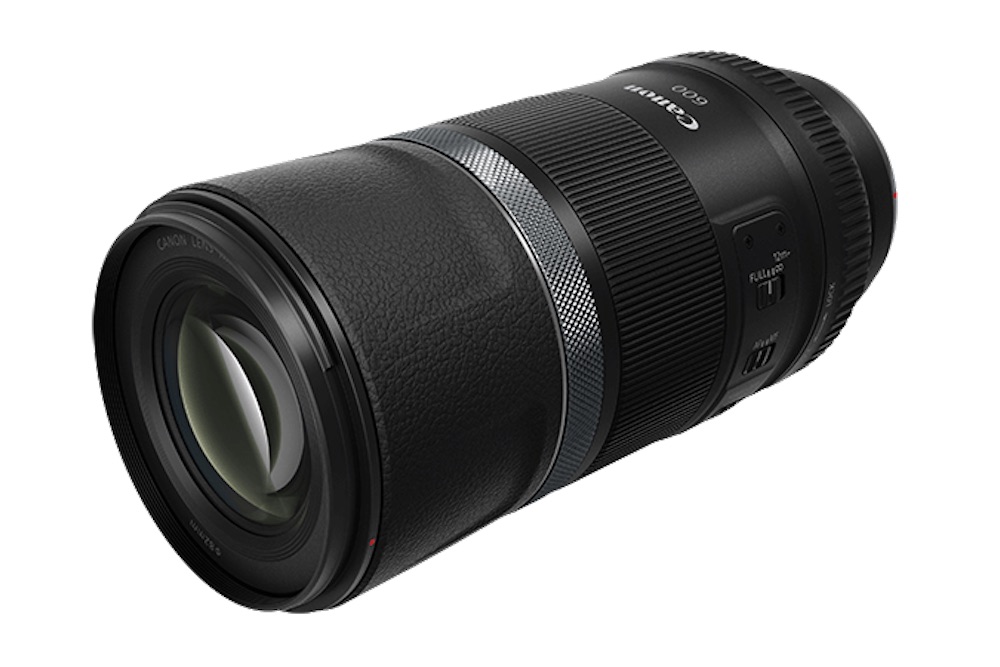
The last two lenses are definitely weird. They are collapsible, fixed-aperture, Fresnel, f11 lenses with very long focal lengths of 600 and 800mm. Any lens that is fixed-aperture, Fresnel OR f11 is a notable member of the “optical zoo”, and a lens that is ALL of the above plus collapsible (slightly more common) is one of the most unusual lenses we’ve seen in a while. They are the least expensive lenses this long we’ve seen from a major manufacturer in decades ($699 for the 600mm and $899 for the 800mm). No matter how sharp they might be, they are diffraction limited wide open (which is the only way they operate – remember that these are fixed-aperture lenses) on the EOS-R5, the EOS-R and the EOS-RP. The relatively low resolution of the EOS-R6 puts them right on the edge of diffraction on that body.
Oh, if that’s not weird enough, they actually take teleconverters… Supposedly, the R5 and R6 will autofocus (in REALLY bright light) with the 800mm f11 and a 2x teleconverter. This stunt lens is a 1600mm f22! Due to diffraction, the image is only around 6mp in effective resolution – but the only other way I know of getting a 1600mm lens for under $10,000 is one of Nikon’s ultra-zoom point and shoots, and those are diffraction limited to around 2 mp, with much less dynamic range. Of course, you could crop a shorter lens. The Nikkor 500mm f5.6 PF with a 1.4x teleconverter is a good candidate – 720mm f8, barely NOT diffraction limited on a Z7 or D850 (according to Cambridge in Colour’s calculator – some others are stricter). Crop down to about 10-11 mp, and it’s a 1600mm equivalent. Of course, the diffraction on the Canon f11 lenses is bad enough that the teleconverter is pretty much pointless – you lose enough to diffraction at f16 or f22 that you might as well just crop the image from the unconverted lens. You’ll still be closer to 6 or 8 mp than the 11 or so that the shorter Nikkor with converter and crop could give you, but it’s a much cheaper lens.
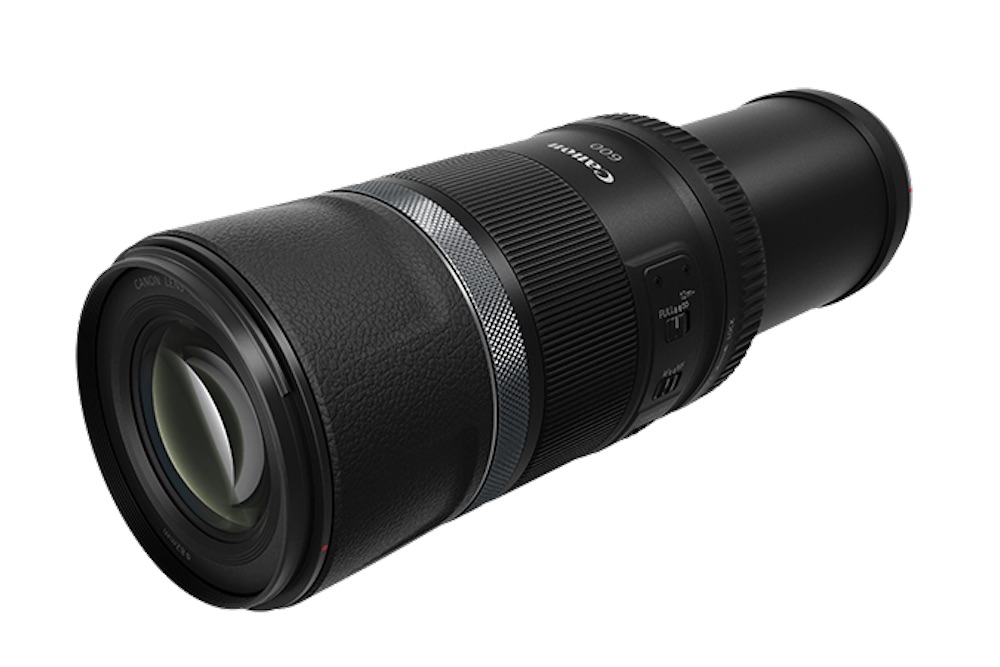
What do we make of these charter members of the optical zoo? They are somewhere in the range of a weird hybrid between previous Canon DO and Nikon PF lenses, cheap no-name T-mount ultratelephotos and a pirate’s collapsible spyglass. Unlike other DO and PF lenses but like the cheap T-mount lenses and the pirate’s glass, they’re optically simple (10 elements in 7 groups on the 600mm, 11/8 on the 800mm). They autofocus, like DO/PF lenses and unlike cheap T-mount lenses. Like a pirate’s spyglass, they collapse for storage, extend for use, and (unlike an average extending zoom lens) won’t focus at all when collapsed. While it is of no optical relation at all, probably the closest lens in concept I can think of was Minolta’s 500mm f8 autofocusing mirror lens. It took an unusual design often used for very cheap lenses, spruced it up and added autofocus, and produced a notably compact, if slow ultratelephoto for a decent price.
While Canon thought commendably out of the box on these, who are they really for? The 800mm is almost certainly more useful than the 600mm, because there are more ways of getting to 600mm without accepting f11 to get there. While Canon doesn’t make a super-long zoom in the 200-500 or 200-600mm range themselves (other than the RF 100-500mm discussed above), there are several decent third-party options in that range from Sigma and Tamron (EF mount, but compatible with Canon’s mount adapters). If we look across the industry, including at lenses that would be hard or impossible to put on a Canon body, Nikon and Sony both make excellent first-party zooms in that range. These lenses are generally f5.6 at 500mm and f6.3 at 600mm, 1 2/3 or 2 stops faster than the Canons. While they are significantly heavier and at least somewhat more expensive, the best of them are very sharp lenses, compared to the f11 Canons that will be fighting diffraction. If the (similarly sized to the 600mm f11) 100-500mm RF lives up to what we expect of a Canon L lens, cropping it in to “600mm” will almost certainly be much sharper than the f11 lens, although it is also much more expensive.
At 800mm, the only other reasonably priced option will be a long zoom with a 1.4x teleconverter (or a long zoom cropped in). It’ll still be 2/3 to a full stop faster than the Canon lens at 720mm f8 or 840mm f9 – but at least it’s not a couple of stops faster. The teleconverter will steal some sharpness, too. Will that be significantly better than the 800mm f11? Canon doesn’t make a 500mm f5.6 prime that might take a converter better than the Sigma or Tamron zooms would – the 500mm f5.6 PF Nikkor with a converter would certainly be much sharper, even after cropping from 720mm in to 800mm, but that’s the wrong mount and several times the price. There is really no other way to 800mm that is likely to be much sharper (if Canon has made the 800mm f11 as good as it can be with the limits of f11) for less than about $3000, and the 800mm f11 is an under $1000 lens. The best alternative might well be a zoom that ends at 500 or 600mm around f5.6 or f6.3, then cropping in to 800mm. Especially on a higher resolution body where f11 takes more of a toll and there’s more room to crop., that’s likely to be sharper than the diffraction limited lens.
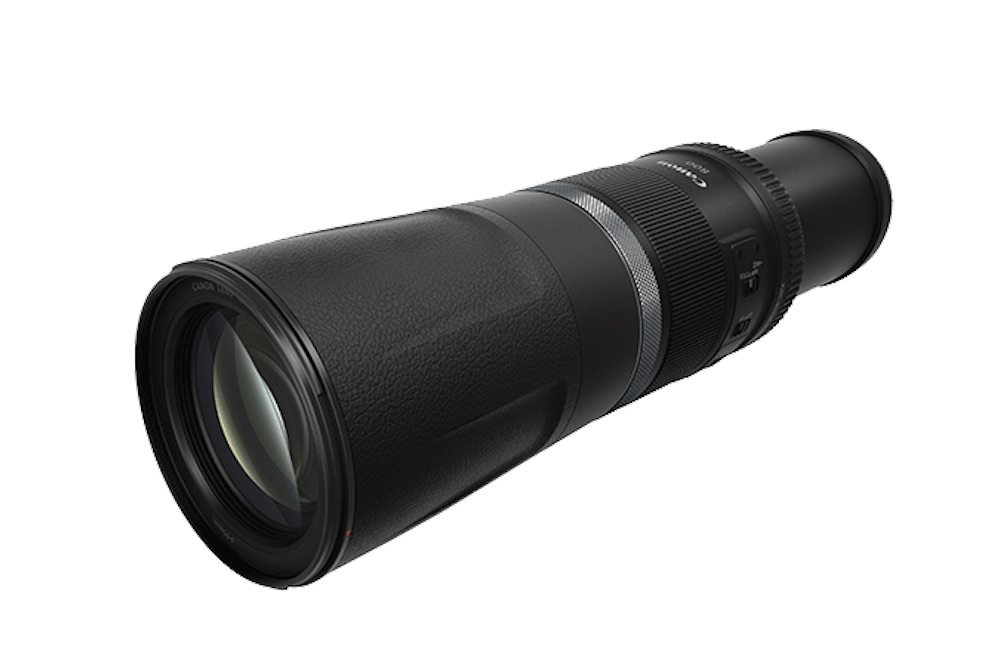
One group that is likely to appreciate the 800mm f11 is birders. People are willing to hold or clamp iPhones up to the eyepieces of spotting scopes to get blurry, but identifiable photos of birds. If these were EF lenses, a significant number of birders probably already own various Canon DSLRs, and many of them might buy the lens for its significant improvement over anything jury-rigged to a scope. The problem is that these are RF lenses, meaning that the random Canon camera hanging around many houses won’t work. Even an EOS-RP, while remarkably inexpensive for a full-frame camera, would drive the total cost up to $2000 or more.
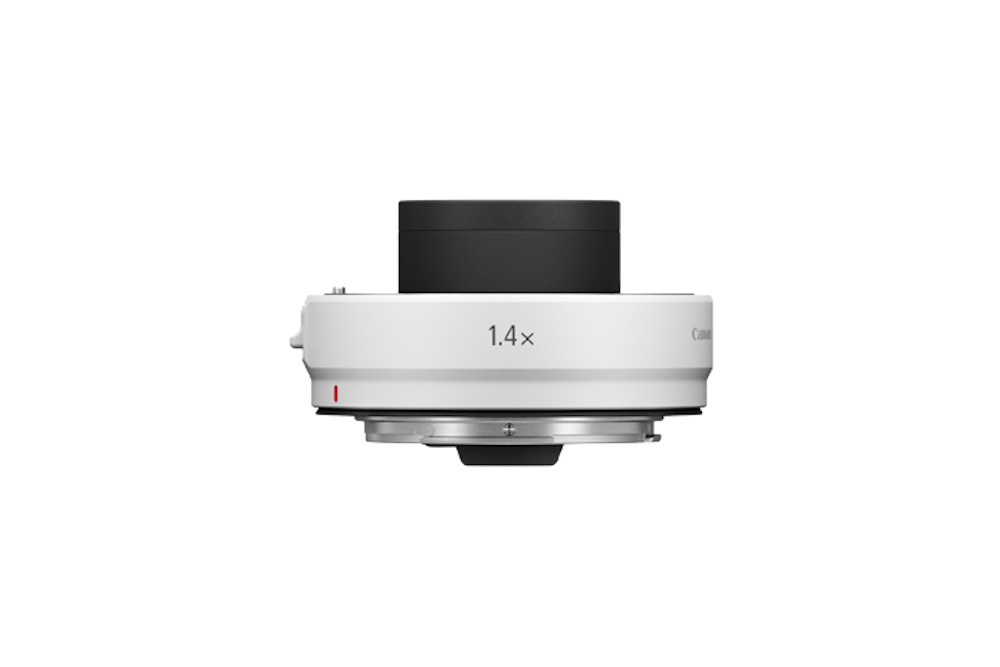
The two teleconverters are likely to be basically like any other high-quality teleconverter from a camera manufacturer. There is no information right now suggesting that they are either especially excellent or especially lousy – as far as I can tell, nobody has used one yet. The one confusing part about the introductions is what lenses they are intended for. Teleconverters tend to work best with long, fast primes and secondly with long, relatively fast zooms. Occasionally, you’ll throw one on an unusual lens (macro and tilt-shift lenses are sometimes candidates). Why would anyone ever put a teleconverter on, say, a 35mm lens – just use an easily available 50mm lens (unless the 35mm lens happens to be a $2000 tilt-shift lens)? There are, as yet, no long, fast RF primes at all, and only one long, fast zoom (the 70-200mm f2.8). Even more oddly, the converters don’t work with the 70-200mm! The only three lenses the converters work with so far are the 100-500mm f4.5-7.1 (only from 300-500mm) and the two f11 oddities! The 100-500mm is a reasonable candidate, especially for the 1.4x converter, although it is getting pretty slow at the long end. Due to diffraction, the two oddities probably don’t gain anything from the converters at all – you’d be just as well off to crop. The converters (at $499 and $599) are also a substantial portion of the price of the odd f11 lenses (although much more reasonably priced compared to the 100-500mm).
Of course, Canon has been known to release things in the RF system that seem to make no sense, and then to release the item that goes with them months or years later. Case in point: the unstabilized 28-70mm f2.0 lens… It made absolutely no sense on the EOS-RP, and not much more on the original EOS-R – the resolution just wasn’t there to take advantage of a lens like that, and who’d buy a distinctly professional lens for a system where there were only midrange bodies? It also lacked any sort of stabilization, and there was no stabilized body to put it on. Well over a year after the 28-70mm became widely available, the EOS-R5 came out – aha, here’s the body that lens is meant for! A high-resolution, professional-grade body with IBIS matches perfectly with a super-sharp, fast pro lens without stabilization.
The teleconverters will make a lot more sense the day the unannounced 300mm f2.8 DO RF lens (or something similar) comes out! As of right now, the teleconverters would actually make more sense if they were RF on the camera side, but EF on the lens side – they could prevent photographers from having to stack an EF lens, an EF teleconverter and a mount adapter to use a long prime and a teleconverter on an RF body. The fact that they’re not mount-converting suggests long, fast RF primes may be on the way.
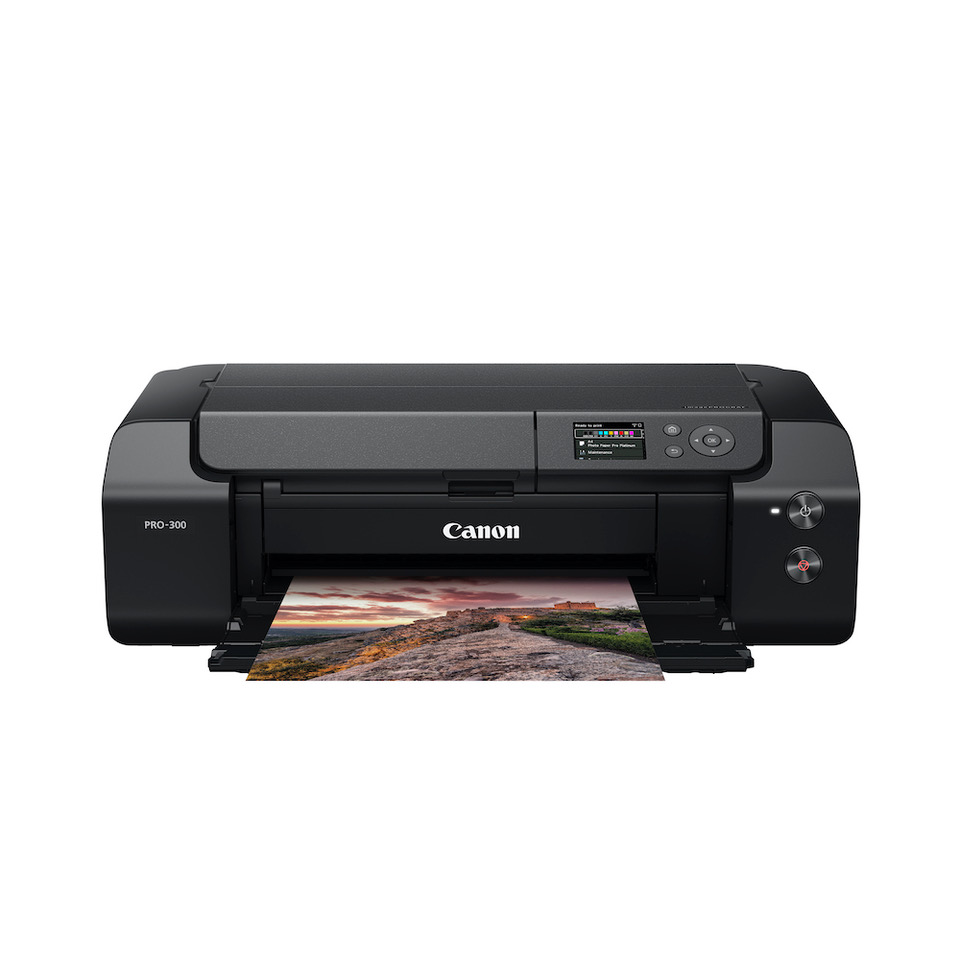
The last item Canon released is the Pro-300 printer. As a replacement for the venerable Pro-10, it brings some of the technologies from the newer Pro-series printers (17” Pro-1000 up through the 60” Pro-6100) to a 30 lb desktop printer. Unlike the other recent Pro-series printers, it doesn’t use exactly the same inkset. One real strength of Canon’s printer line has been that you can proof a print on a 17” desktop Pro-1000 and then do the final print on a 44” Pro 4000/4100 or even a 60” Pro 6000/6100 (if you can find one) – they actually all use not only the same inks, but the same printhead as well.
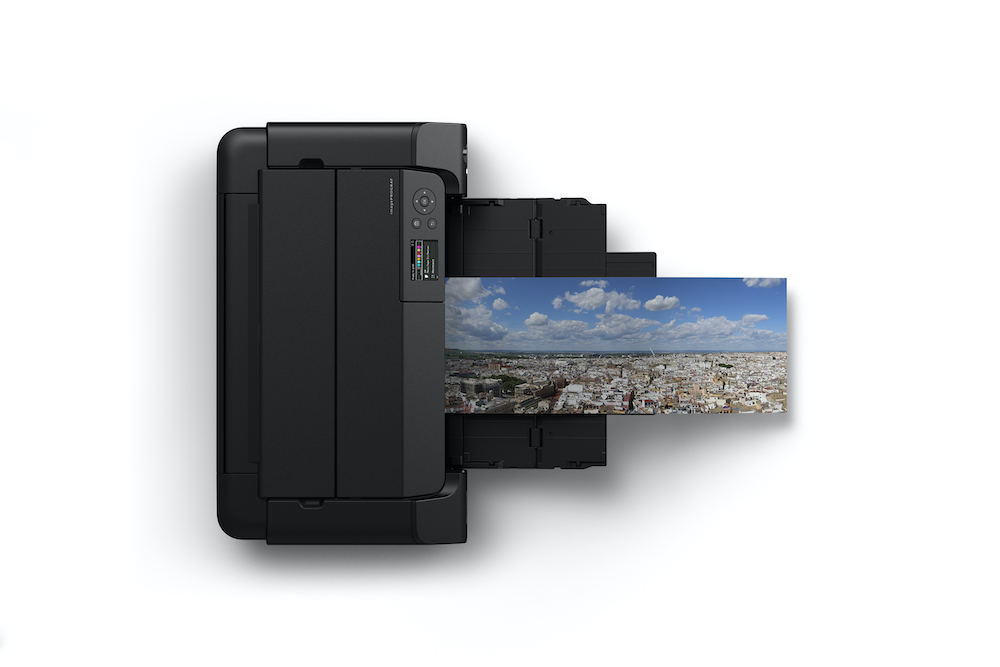
The Pro-300 uses a very similar inkset to the Pro-1000 to Pro-6000 line, but drops one of the grays and the blue ink. I haven’t seen results from a Pro-300 yet, but, owning both an older Pro-10 and a Pro-2000, I’ll be very interested to see how it compares. The Pro-300 uses Canon’s annoying little 14 ml ink cartridges, while the Pro-1000 uses 80ml cartridges and the larger printers offer a choice of 160, 300 and 700 ml. The choice of the small cartridges keeps the size and weight of the Pro-300 down, and it means that each cartridge is not expensive to replace (they’re $13-$15 each), but it means you’ll always be replacing one cartridge or another – keep spares on hand!
One important question about the Pro-300 is going to be value. The Pro-300 lists for $899, while the Pro-1000 lists for $1299 (and sometimes has significant rebates – $300 is not uncommon, bringing it within $100 of the Pro-300’s list price). The Pro-1000 includes $700 worth of ink in the box, to the Pro-300’s $150. Canon will need to rebate the Pro-300 substantially or include extra ink, either in the box or as a mail-in offer, simply in order to compete with its own big brother.
All in all, the most exciting Introduction Day from Canon in years – possibly since the original EOS-5D! One of the most exciting sets of introductions anywhere in the industry in quite a while, certainly since Nikon and Canon entered the mirrorless market in earnest. A very wide range of products, from the groundbreaking to the quixotic…
Dan Wells
July 2020

Lorem ipsum dolor sit amet, consectetur adipiscing elit, sed do eiusmod tempor incididunt ut labore et dolore magna aliqua. Ut enim ad minim veniam, quis nostrud exercitation ullamco laboris nisi ut aliquip ex ea commodo consequat. Duis aute irure dolor in reprehenderit in voluptate velit esse cillum dolore eu fugiat nulla pariatur. Excepteur sint occaecat cupidatat non proident, sunt in culpa qui officia deserunt mollit anim id est laborum.
Lorem ipsum dolor sit amet, consectetur adipiscing elit, sed do eiusmod tempor incididunt ut labore et dolore magna aliqua. Ut enim ad minim veniam, quis nostrud exercitation ullamco laboris nisi ut aliquip ex ea commodo consequat. Duis aute irure dolor in reprehenderit in voluptate velit esse cillum dolore eu fugiat nulla pariatur. Excepteur sint occaecat cupidatat non proident, sunt in culpa qui officia deserunt mollit anim id est laborum.

Lorem ipsum dolor sit amet, consectetur adipiscing elit, sed do eiusmod tempor incididunt ut labore et dolore magna aliqua. Ut enim ad minim veniam, quis nostrud exercitation ullamco laboris nisi ut aliquip ex ea commodo consequat. Duis aute irure dolor in reprehenderit in voluptate velit esse cillum dolore eu fugiat nulla pariatur. Excepteur sint occaecat cupidatat non proident, sunt in culpa qui officia deserunt mollit anim id est laborum.
Lorem ipsum dolor sit amet, consectetur adipiscing elit, sed do eiusmod tempor incididunt ut labore et dolore magna aliqua. Ut enim ad minim veniam, quis nostrud exercitation ullamco laboris nisi ut aliquip ex ea commodo consequat. Duis aute irure dolor in reprehenderit in voluptate velit esse cillum dolore eu fugiat nulla pariatur. Excepteur sint occaecat cupidatat non proident, sunt in culpa qui officia deserunt mollit anim id est laborum.

Lorem ipsum dolor sit amet, consectetur adipiscing elit, sed do eiusmod tempor incididunt ut labore et dolore magna aliqua. Ut enim ad minim veniam, quis nostrud exercitation ullamco laboris nisi ut aliquip ex ea commodo consequat. Duis aute irure dolor in reprehenderit in voluptate velit esse cillum dolore eu fugiat nulla pariatur. Excepteur sint occaecat cupidatat non proident, sunt in culpa qui officia deserunt mollit anim id est laborum.
Lorem ipsum dolor sit amet, consectetur adipiscing elit, sed do eiusmod tempor incididunt ut labore et dolore magna aliqua. Ut enim ad minim veniam, quis nostrud exercitation ullamco laboris nisi ut aliquip ex ea commodo consequat. Duis aute irure dolor in reprehenderit in voluptate velit esse cillum dolore eu fugiat nulla pariatur. Excepteur sint occaecat cupidatat non proident, sunt in culpa qui officia deserunt mollit anim id est laborum.

Lorem ipsum dolor sit amet, consectetur adipiscing elit, sed do eiusmod tempor incididunt ut labore et dolore magna aliqua. Ut enim ad minim veniam, quis nostrud exercitation ullamco laboris nisi ut aliquip ex ea commodo consequat. Duis aute irure dolor in reprehenderit in voluptate velit esse cillum dolore eu fugiat nulla pariatur. Excepteur sint occaecat cupidatat non proident, sunt in culpa qui officia deserunt mollit anim id est laborum.
Lorem ipsum dolor sit amet, consectetur adipiscing elit, sed do eiusmod tempor incididunt ut labore et dolore magna aliqua. Ut enim ad minim veniam, quis nostrud exercitation ullamco laboris nisi ut aliquip ex ea commodo consequat. Duis aute irure dolor in reprehenderit in voluptate velit esse cillum dolore eu fugiat nulla pariatur. Excepteur sint occaecat cupidatat non proident, sunt in culpa qui officia deserunt mollit anim id est laborum.
Lorem ipsum dolor sit amet, consectetur adipiscing elit, sed do eiusmod tempor incididunt ut labore et dolore magna aliqua. Ut enim ad minim veniam, quis nostrud exercitation ullamco laboris nisi ut aliquip ex ea commodo consequat. Duis aute irure dolor in reprehenderit in voluptate velit esse cillum dolore eu fugiat nulla pariatur. Excepteur sint occaecat cupidatat non proident, sunt in culpa qui officia deserunt mollit anim id est laborum.

Lorem ipsum dolor sit amet, consectetur adipiscing elit, sed do eiusmod tempor incididunt ut labore et dolore magna aliqua. Ut enim ad minim veniam, quis nostrud exercitation ullamco laboris nisi ut aliquip ex ea commodo consequat. Duis aute irure dolor in reprehenderit in voluptate velit esse cillum dolore eu fugiat nulla pariatur. Excepteur sint occaecat cupidatat non proident, sunt in culpa qui officia deserunt mollit anim id est laborum.

Lorem ipsum dolor sit amet, consectetur adipiscing elit, sed do eiusmod tempor incididunt ut labore et dolore magna aliqua. Ut enim ad minim veniam, quis nostrud exercitation ullamco laboris nisi ut aliquip ex ea commodo consequat. Duis aute irure dolor in reprehenderit in voluptate velit esse cillum dolore eu fugiat nulla pariatur. Excepteur sint occaecat cupidatat non proident, sunt in culpa qui officia deserunt mollit anim id est laborum.
Lorem ipsum dolor sit amet, consectetur adipiscing elit, sed do eiusmod tempor incididunt ut labore et dolore magna aliqua. Ut enim ad minim veniam, quis nostrud exercitation ullamco laboris nisi ut aliquip ex ea commodo consequat. Duis aute irure dolor in reprehenderit in voluptate velit esse cillum dolore eu fugiat nulla pariatur. Excepteur sint occaecat cupidatat non proident, sunt in culpa qui officia deserunt mollit anim id est laborum.

Lorem ipsum dolor sit amet, consectetur adipiscing elit, sed do eiusmod tempor incididunt ut labore et dolore magna aliqua. Ut enim ad minim veniam, quis nostrud exercitation ullamco laboris nisi ut aliquip ex ea commodo consequat. Duis aute irure dolor in reprehenderit in voluptate velit esse cillum dolore eu fugiat nulla pariatur. Excepteur sint occaecat cupidatat non proident, sunt in culpa qui officia deserunt mollit anim id est laborum.
Lorem ipsum dolor sit amet, consectetur adipiscing elit, sed do eiusmod tempor incididunt ut labore et dolore magna aliqua. Ut enim ad minim veniam, quis nostrud exercitation ullamco laboris nisi ut aliquip ex ea commodo consequat. Duis aute irure dolor in reprehenderit in voluptate velit esse cillum dolore eu fugiat nulla pariatur. Excepteur sint occaecat cupidatat non proident, sunt in culpa qui officia deserunt mollit anim id est laborum.
Lorem ipsum dolor sit amet, consectetur adipiscing elit, sed do eiusmod tempor incididunt ut labore et dolore magna aliqua. Ut enim ad minim veniam, quis nostrud exercitation ullamco laboris nisi ut aliquip ex ea commodo consequat. Duis aute irure dolor in reprehenderit in voluptate velit esse cillum dolore eu fugiat nulla pariatur. Excepteur sint occaecat cupidatat non proident, sunt in culpa qui officia deserunt mollit anim id est laborum.
Lorem ipsum dolor sit amet, consectetur adipiscing elit, sed do eiusmod tempor incididunt ut labore et dolore magna aliqua. Ut enim ad minim veniam, quis nostrud exercitation ullamco laboris nisi ut aliquip ex ea commodo consequat. Duis aute irure dolor in reprehenderit in voluptate velit esse cillum dolore eu fugiat nulla pariatur. Excepteur sint occaecat cupidatat non proident, sunt in culpa qui officia deserunt mollit anim id est laborum.

Lorem ipsum dolor sit amet, consectetur adipiscing elit, sed do eiusmod tempor incididunt ut labore et dolore magna aliqua. Ut enim ad minim veniam, quis nostrud exercitation ullamco laboris nisi ut aliquip ex ea commodo consequat. Duis aute irure dolor in reprehenderit in voluptate velit esse cillum dolore eu fugiat nulla pariatur. Excepteur sint occaecat cupidatat non proident, sunt in culpa qui officia deserunt mollit anim id est laborum.
Lorem ipsum dolor sit amet, consectetur adipiscing elit, sed do eiusmod tempor incididunt ut labore et dolore magna aliqua. Ut enim ad minim veniam, quis nostrud exercitation ullamco laboris nisi ut aliquip ex ea commodo consequat. Duis aute irure dolor in reprehenderit in voluptate velit esse cillum dolore eu fugiat nulla pariatur. Excepteur sint occaecat cupidatat non proident, sunt in culpa qui officia deserunt mollit anim id est laborum.
Lorem ipsum dolor sit amet, consectetur adipiscing elit, sed do eiusmod tempor incididunt ut labore et dolore magna aliqua. Ut enim ad minim veniam, quis nostrud exercitation ullamco laboris nisi ut aliquip ex ea commodo consequat. Duis aute irure dolor in reprehenderit in voluptate velit esse cillum dolore eu fugiat nulla pariatur. Excepteur sint occaecat cupidatat non proident, sunt in culpa qui officia deserunt mollit anim id est laborum.
Lorem ipsum dolor sit amet, consectetur adipiscing elit, sed do eiusmod tempor incididunt ut labore et dolore magna aliqua. Ut enim ad minim veniam, quis nostrud exercitation ullamco laboris nisi ut aliquip ex ea commodo consequat. Duis aute irure dolor in reprehenderit in voluptate velit esse cillum dolore eu fugiat nulla pariatur. Excepteur sint occaecat cupidatat non proident, sunt in culpa qui officia deserunt mollit anim id est laborum.

Lorem ipsum dolor sit amet, consectetur adipiscing elit, sed do eiusmod tempor incididunt ut labore et dolore magna aliqua. Ut enim ad minim veniam, quis nostrud exercitation ullamco laboris nisi ut aliquip ex ea commodo consequat. Duis aute irure dolor in reprehenderit in voluptate velit esse cillum dolore eu fugiat nulla pariatur. Excepteur sint occaecat cupidatat non proident, sunt in culpa qui officia deserunt mollit anim id est laborum.
Lorem ipsum dolor sit amet, consectetur adipiscing elit, sed do eiusmod tempor incididunt ut labore et dolore magna aliqua. Ut enim ad minim veniam, quis nostrud exercitation ullamco laboris nisi ut aliquip ex ea commodo consequat. Duis aute irure dolor in reprehenderit in voluptate velit esse cillum dolore eu fugiat nulla pariatur. Excepteur sint occaecat cupidatat non proident, sunt in culpa qui officia deserunt mollit anim id est laborum.
Lorem ipsum dolor sit amet, consectetur adipiscing elit, sed do eiusmod tempor incididunt ut labore et dolore magna aliqua. Ut enim ad minim veniam, quis nostrud exercitation ullamco laboris nisi ut aliquip ex ea commodo consequat. Duis aute irure dolor in reprehenderit in voluptate velit esse cillum dolore eu fugiat nulla pariatur. Excepteur sint occaecat cupidatat non proident, sunt in culpa qui officia deserunt mollit anim id est laborum.
Lorem ipsum dolor sit amet, consectetur adipiscing elit, sed do eiusmod tempor incididunt ut labore et dolore magna aliqua. Ut enim ad minim veniam, quis nostrud exercitation ullamco laboris nisi ut aliquip ex ea commodo consequat. Duis aute irure dolor in reprehenderit in voluptate velit esse cillum dolore eu fugiat nulla pariatur. Excepteur sint occaecat cupidatat non proident, sunt in culpa qui officia deserunt mollit anim id est laborum.

Lorem ipsum dolor sit amet, consectetur adipiscing elit, sed do eiusmod tempor incididunt ut labore et dolore magna aliqua. Ut enim ad minim veniam, quis nostrud exercitation ullamco laboris nisi ut aliquip ex ea commodo consequat. Duis aute irure dolor in reprehenderit in voluptate velit esse cillum dolore eu fugiat nulla pariatur. Excepteur sint occaecat cupidatat non proident, sunt in culpa qui officia deserunt mollit anim id est laborum.
Lorem ipsum dolor sit amet, consectetur adipiscing elit, sed do eiusmod tempor incididunt ut labore et dolore magna aliqua. Ut enim ad minim veniam, quis nostrud exercitation ullamco laboris nisi ut aliquip ex ea commodo consequat. Duis aute irure dolor in reprehenderit in voluptate velit esse cillum dolore eu fugiat nulla pariatur. Excepteur sint occaecat cupidatat non proident, sunt in culpa qui officia deserunt mollit anim id est laborum.

Lorem ipsum dolor sit amet, consectetur adipiscing elit, sed do eiusmod tempor incididunt ut labore et dolore magna aliqua. Ut enim ad minim veniam, quis nostrud exercitation ullamco laboris nisi ut aliquip ex ea commodo consequat. Duis aute irure dolor in reprehenderit in voluptate velit esse cillum dolore eu fugiat nulla pariatur. Excepteur sint occaecat cupidatat non proident, sunt in culpa qui officia deserunt mollit anim id est laborum.
Lorem ipsum dolor sit amet, consectetur adipiscing elit, sed do eiusmod tempor incididunt ut labore et dolore magna aliqua. Ut enim ad minim veniam, quis nostrud exercitation ullamco laboris nisi ut aliquip ex ea commodo consequat. Duis aute irure dolor in reprehenderit in voluptate velit esse cillum dolore eu fugiat nulla pariatur. Excepteur sint occaecat cupidatat non proident, sunt in culpa qui officia deserunt mollit anim id est laborum.
You May Also Enjoy...
Hand’s On: new Sony A9III and Sony 50mm G Master, Sony 85mm G Master, Sony 75-350mm APS lenses
A quick hands on look at Sony A9iii and the Sony APS 75-350mm len
The best wide-angle zoom in the world? The Fujinon G5 20-35mm f4 R WR reviewed.
FUJIFILM GF 20-35mm f/4 R WR L
